Long Division to Decimal Places
When we do long division, it doesn't always result in a whole number. Sometimes there are numbers left over. We can continue the long division process to find the answer to a certain number of decimal places.
The key to extending long division into decimals is knowing that we can add zeros after the decimal point.
Example: 150 is the same as 150.00
We can add as many zeros as needed after the decimal point without changing the number’s value.
We will use the example below. It works out neatly to one decimal place:
If you feel happy with the process on the long division page you can skip the first bit.
 |
4 ÷ 25 = 0 remainder 4 | The first number of the dividend is divided by the divisor. |
 |
The whole number result is placed at the top. Any remainders are ignored at this point. | |
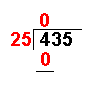 |
25 × 0 = 0 | The answer from the first operation is multiplied by the divisor. The result is placed under the number divided into. |
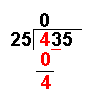 |
4 − 0 = 4 | Now we take away the bottom number from the top number. |
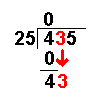 |
Bring down the next number of the dividend. | |
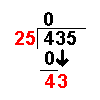 |
43 ÷ 25 = 1 remainder 18 | Divide this number by the divisor. |
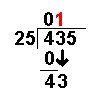 |
The whole number result is placed at the top. Any remainders are ignored at this point. | |
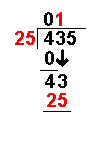 |
25 × 1 = 25 | The answer from the above operation is multiplied by the divisor. The result is placed under the last number divided into. |
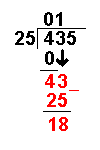 |
43 − 25 = 18 | Now we take away the bottom number from the top number. |
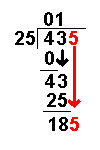 |
Bring down the next number of the dividend. | |
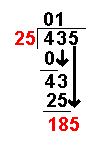 |
185 ÷ 25 = 7 remainder 10 | Divide this number by the divisor. |
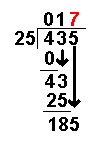 |
The whole number result is placed at the top. Any remainders are ignored at this point. | |
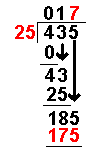 |
25 × 7 = 175 | The answer from the above operation is multiplied by the divisor. The result is placed under the number divided into. |
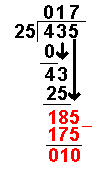 |
185 − 175 = 10 | Now we take away the bottom number from the top number. |
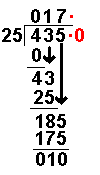 |
Now we have reached the end of the whole numbers we add a decimal place and the first zero. Notice the decimal point which has appeared on the answer line and by the dividend. It does not appear anywhere else. | |
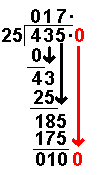 |
Bring down the next number of the dividend. | |
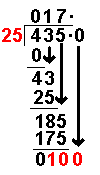 |
100 ÷ 25 = 4 remainder 0 | Divide this number by the divisor. |
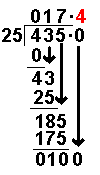 |
The whole number result is placed at the top. Any remainders are ignored at this point. | |
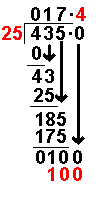 |
25 × 4 = 100 | The answer from the above operation is multiplied by the divisor. The result is placed under the number divided into. |
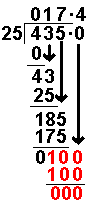 |
100 − 100 = 0 | Now we take away the bottom number from the top number. |
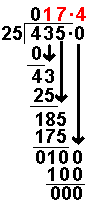 |
The subtraction has given zero. We stop when this happens. The answer is 17.4 As long as the subtraction gives a number above zero the long division can carry on to as many decimal places as we wish.
Answer: 435 ÷ 25 = 17.4 |
